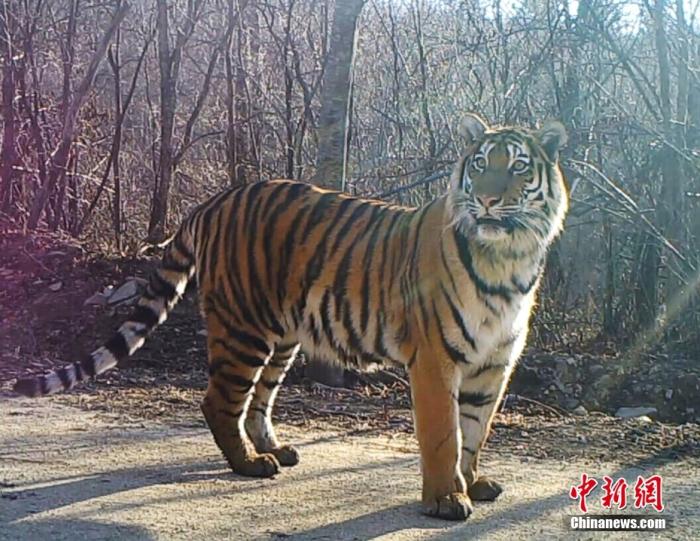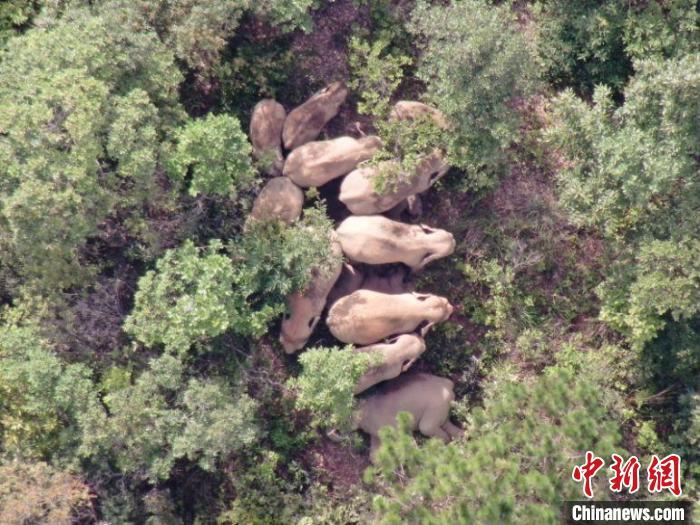Frequent appearances of wild animals in China indicate recent improvements to their habitats
China has frequently reported sightings of wild animals such as Siberian tigers and wild Asian elephants in recent years. This can be interpreted as a reflection of significant improvements to the natural habitats of wildlife in the country, according to Yang Zhongqi, a member of the 13th National Committee of the Chinese People's Political Consultative Conference (CPPCC).

Photo taken by an infrared camera shows a Siberian tiger. (Photo courtesy of the forestry and grassland bureau of Jilin Province)
Yang, also an expert at the Chinese Academy of Forestry, took Siberian tigers as an example and explained that thanks to the restoration of forests and biodiversity across the country in recent years, food supplies for the tigers have increased. Consequently, many of the tigers that had previously left their original habitats in China for Russia have since returned and re-settled in the country’s northeast region.
In 2017, China launched a pilot national park project for Siberian tigers and Amur leopards, and then built a national park for the two animal species, spanning an area of 14,000 square kilometers in northeast China's Jilin and Heilongjiang provinces. The sheer size of the park can help guarantee a large enough natural habitat and abundant food supplies for the apex predators in the ecosystem, according to Feng Limin, deputy director of a monitoring and research center for Siberian tigers and Amur leopards under the National Forestry and Grassland Administration.
Thanks to the park, the past four years have witnessed a rapid recovery of the two species. The number of wild Siberian tigers in the park has increased from 27 to 50, while the amount of Amur leopards has climbed from 42 to over 60, according to Feng, who is also an associate professor at Beijing Normal University.

Photo shows a herd of wild Asian elephants travelling north from their forest home in southern Yunnan's Xishuangbanna Dai Autonomous Prefecture. (Photo courtesy of Yunnan Forest Fire Brigade)
Besides, a herd of wild Asian elephants travelling north from their forested home in southern Yunnan's Xishuangbanna Dai Autonomous Prefecture finally returned to their reserve last year, the miraculous migration having garnered enormous attention. “The successful returning of the wandering elephants is largely attributable to people’s protection, plenty of crops, and forests for them to rest along the way,” introduced Chen Fei, director of a research center on Asia elephants under the National Forestry and Grassland Administration.
He added that the latest footage shows that these wild creatures are now in a good condition. A baby elephant born during the journey has grown up and has started to learn some survival skills from other family members in the herd.
Just like wild tigers, the number of wild elephants has followed a downward trend worldwide. In China, however, the number of wild elephants has risen from about 150 in the 1970s to around 300 today, according to Chen.
Photos
Related Stories
- Rare photos of varied cast of wild creatures captured in nature reserve in C China’s Hunan
- In pics: wild animals in Gaborone Game Reserve in Botswana
- Various wild animals captured by infrared camera at nature reserve in SW China
- China’s Qilian Mountain National Park: home to a wide variety of rare wild animals
- Residents in N China's Inner Mongolia persistently protect rare wild animals
- Chinese, African experts host forum to discuss protection of wild species
- More wild animals spotted in China: official
- Wild leopard cats captured on camera for first time at a nature reserve in NW China
- Stay away from wild animals, China takes sustained action against illegal wildlife trade
- Tibetan family saves wild animals on 4,000-meter-high plateau
Copyright © 2022 People's Daily Online. All Rights Reserved.










